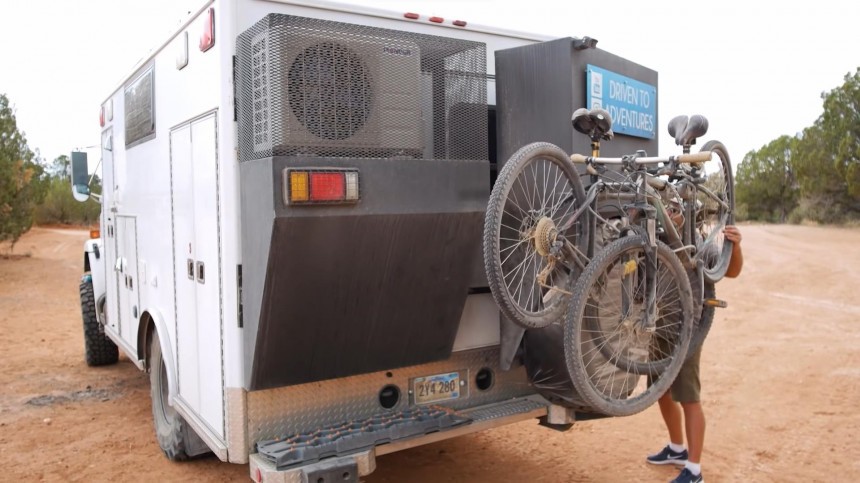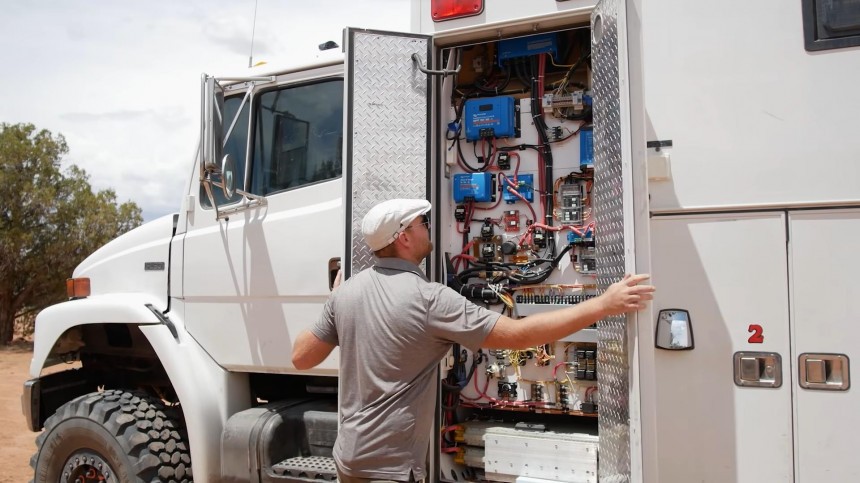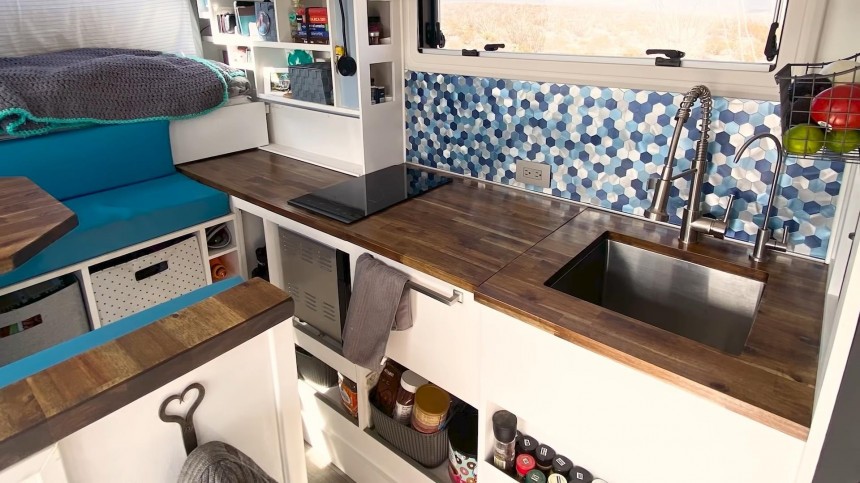I've covered multiple ambulance camper builds here on autoevolution. But the one I'm checking out today might be better in terms of overland travel. Equipped with many clever features, it boasts an extremely efficient living space. But my favorite part is that it didn't cost that much to make.
Meet Greg and Ginger, the owners and builders of this custom DIY ambulance tiny house. Before we get into details about the vehicle, let's tell you more about this couple. Their stories may inspire you to take the leap into a mobile lifestyle.
Greg and Ginger had limited vacation days, so they had to rein in their adventurous spirit. They were always looking forward to more vacations so they could travel more. At one point, Ginger asked Greg if he wanted to do this full time.
After trying out the mobile lifestyle, they realized they wanted to explore more off-road. So they opted for a four-wheel drive ambulance. They bought this unit unseen after months of searching as they were quarantined in Mexico. The purpose of their campervan was not only to help them travel off the beaten path, but also to allow them to enjoy long, four-season trips off the grid.
What we have here is a Freightliner FL60 ambulance with an 8.3 liter Cummins engine and Allison automatic transmission. It is 25 feet (7.6 meters) long and 10.5 feet (3.2 meters) high. Additionally, this beast gets around 10 MPG (23.5 L/100km) on the highway.

Photo: YouTube Screenshot / Tiny House Giant Journey
Initially, the pair had budgeted $56,000 (€51,917) for the entire build, including the base vehicle. For an overlander, especially a well-equipped overlander (as we'll see in a moment), this is no big deal. In the end, they spent a total of $59,000 (€51,917), just $3,000 (€2,781) over budget. One of the most important ways we succeeded in minimizing costs was to perform the conversion in-house.
The couple likely chose this large vehicle for its ruggedness, safety, and off-road capabilities. Additionally, this rig rides on split aluminum rims wrapped in bulky Continental off-road tires.
As Greg explained, it's important to consider the engine hours of the ambulance engine, not the miles on the odometer. Ambulances don't usually travel long distances, but they do sit idle for long periods of time to keep medical equipment running.
In addition to the tires, the couple made several exterior upgrades to the rig. Her one of the most important was related to the capacity of the fuel tank. The vehicle had a 40-gallon (151-litre) fuel tank, but the pair replaced it with two 55-gallon (208-litre) fuel tanks and drove it for about 900 miles (1,448 km). It is now possible to run.

Photo: YouTube Screenshot / Tiny House Giant Journey
There are three storage compartments on the driver's side. The tall one closest to the driver's cab houses the electrical system, and it's a very powerful system. Its highlights are two 24 V, 433 Ah Tesla batteries and a solar charge controller connected to his 1,200 W solar panel on the roof. It's safe to say that going off-grid is not an issue with this rig.
One of the tricky parts of converting an ambulance is dealing with all the wiring and huge electrical panels. The wiring on this ambulance was a mess. Check out the gallery to see how everything turned out during the remodel. To make matters worse, there was no wiring diagram to follow.
It took Greg a whopping two weeks to route each wire, figure out what it was used for, and get everything organized. And Greg is an electrician. Most of us without experience don't even know how long it takes to do it.
A separate compartment on the driver's side houses the plumbing system. It consists of an electric water heater, a 3-stage water purification system, and a UV filter. Unfortunately, Greg and Ginger did not mention the capacity of the rig's water tank.

Photo: YouTube Screenshot / Tiny House Giant Journey
At the rear, Greg installed a custom-built rack that covers the residential air conditioning, integrates a storage box, and also accommodates two bikes and a spare tire. Additionally, shaking off the half reveals a rear door that leads to the garage under the bed. This is where the couple stores their tools.
All of these features are pretty cool, but not that you don't often see them in other campers. My favorite exterior element is the custom-made hammock holder. It's a very simple addition – a couple can pull out a metal rod with a hook. The hammock can then be attached to the built-in hooks at the end of the bar and next to the rig entrance.
Step inside and you'll immediately notice how spacious the interior is. Although the rig doesn't actually offer a whopping 112 square feet (10.4 square meters) of space, Greg and Ginger have come up with a variety of space-saving solutions.
There is a huge apartment-sized Isotherm fridge/freezer right by the entrance. In addition, there is a residential air conditioner above the door.

Photo: YouTube Screenshot / Tiny House Giant Journey
To the left is the dinette area, consisting of two benches with a dinette table in between. The dinette seat can be extended to accommodate up to 6 people. In addition, the space under the bench seat can be used as storage space.
There is a long window on the wall right next to it, allowing plenty of light into the room. In fact, all windows in the living spaces incorporate insect screens and blackout shades.
There is a bedroom behind the dinette area. This is one of the smart solutions the couple came up with. During the day, the rear part of the bed can be raised to form a backrest and transform the bed into a sofa.
To unfold the couch and convert it back into a bed, the couple must first lower the table in the dinette area. The sofa then fully extends to become a full-sized bed. By the way, all this is done electronically. Additionally, the bed's mattress is installed on the Froli system. Simply put, it's a sleep system designed to circulate air under your mattress and prevent mold from forming.

Photo: YouTube Screenshot / Tiny House Giant Journey
Greg created a custom headboard for the bed that consisted of a scirocco fan and multiple storage spaces. One of them serves as a charging station. Another notable detail in the bedroom is the skylight, which is perfectly positioned for stargazing from the comfort of your bed.
For entertainment, Gre and Ginger installed a Logitech surround-sound speaker system in the room and attached monitors with rotating mounts to the ceiling above the bedroom. This combo is perfect for watching movies in bed with excellent sound.
The kitchen is located on the driver's side of the cabin. Features a lightweight butcher block countertop that provides just the right amount of space, sink, white and blue tiled backsplash, 2-burner induction cooktop, and induction air fryer oven hidden in the slide-out.
One of the clever design features here is the built-in drying rack below the flip-up section of the countertop. Greg and Ginger devised a custom aluminum pan under the rack. This slopes towards the rear and drains directly into the gray water system.

Photo: YouTube Screenshot / Tiny House Giant Journey
The microwave is another hidden appliance, located near the ceiling and built into a sliding drawer with a lock, just like the air fryer oven. Additionally, the largest storage space in the kitchen is the pull-out pantry.
Above the pantry you'll notice the rig's control center. It consists of various switches for lights, fans, tank heaters, etc., as well as a Victron battery monitoring system, an inverter controller, and a floor heating controller.
A compact space next to the pass-through door leading to the driver's cabin is reserved for the toilet – a sign reads “Poop deck” I would like to inform you of this. The bathroom has a composting toilet and a shower with teak mat and curtain.
Overall, I was impressed with Greg and Ginger's ingenuity in building this tiny house on wheels. Although it is relatively compact inside, it is packed with very useful features. This is without a doubt one of the best ambulance campers I've ever written about.



